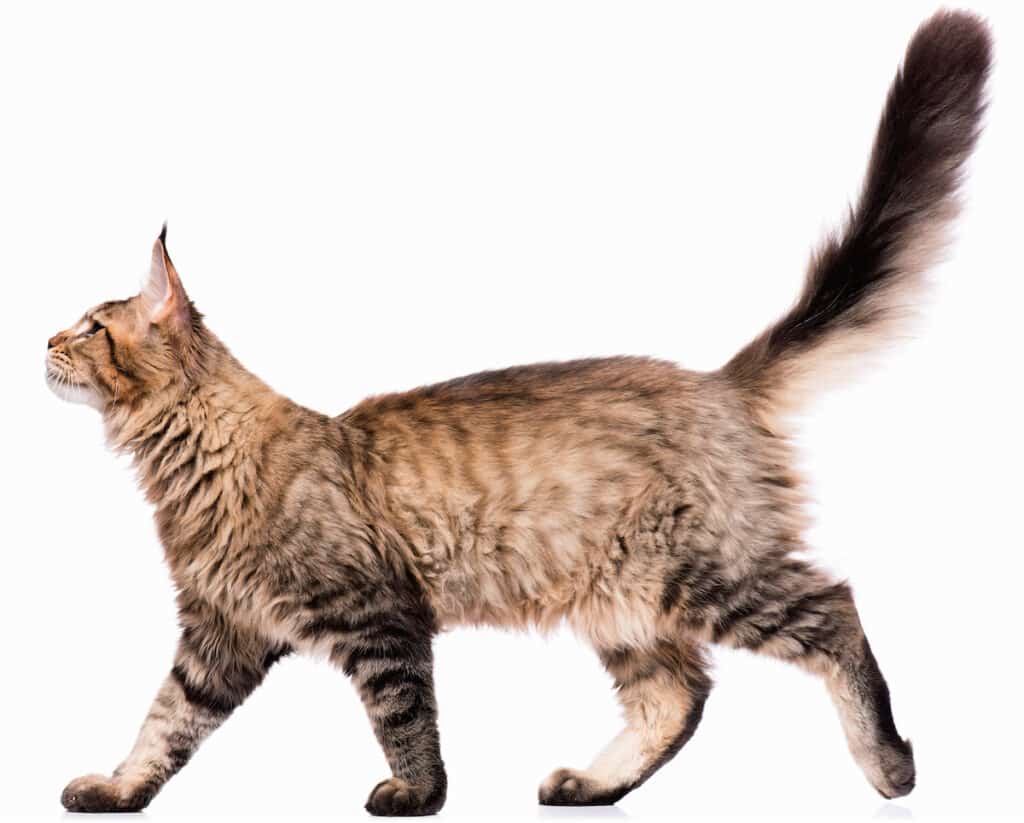Cats have tails mainly for movement and balance, but they also use them for communication. Just about all mammals have tails, in fact, even if you can’t see it.
Cats use their tails as a counterweight to steer them while running or flip themselves over mid-air.
Why Cats Have Tails
Tails are really useful to cats. They have them mainly for movement and balance, but they also use them for communication.
Movement and Balance
Interestingly, cats’ tails help them move quickly and with grace. Like a tightrope walker with a pole, cats’ tails act like a counterbalance. This is why cats can balance on the most precarious things, like a a fence or on the top of doors.
Tails help a cat change direction quickly as it’s running. A shift in the position of the tail acts like a rudder on a boat to steer the cat’s body quickly in a certain direction.
Have you ever wondered how cats always land on their feet? Cats are really good at flipping over mid-air, and their tails help them do just that.
Jumping, running and flipping in the air are all controlled in part by a cat’s tail.
Communication
Like dogs, cats communicate with their tails. Because they can’t use words to communicate how they feel, it’s important to be able to read your cat’s body language. Here are a few moods that you can read by looking at a cat’s tail:
- Happy: Your cat’s tail will either be relaxed or elevated above their head. His tail might vibrate or quiver.
- Scared: Your cat will hold his tail rigidly and straight up, tuck it between his legs or wrap his tail around his body to hide himself.
- Aggressive: Your cat will puff up his tail and hold it high.
- Angry: Your cat’s tail will flick and thrash like a whip.
- Curious: Cats with raised tails that ‘hook’ at the end are often communicating they are curious or interested in you.
Being Related to Other Mammals
Cats have tails in part due to being related to all mammals in general. All mammals have a tail of some sort. Even humans have a small bone in the pelvis where a tail would be if it protruded further.
The distant ancestors of mammals developed tails because they were useful. Over many millions of years they passed down the genes to have tails to all the mammal species that branched off. Even though cats’ tails are useful to them, there are other mammals (like some monkeys) that still have the tail bone but don’t find them useful.
Do Some Cats Not Have Tails?
Some cats, like bobcats, are born without long tails. At some point this species developed a genetic mutation where their tails became very short, almost unnoticeable.
These cats are fine without tails, though, because they developed other mechanisms for counter balancing and moving quickly. Their hind legs are larger and front legs are longer to compensate for the lack of tail.
Can My Cat Break Its Tail?
Because tails have bones in them, they can be broken. Stepping on a cat’s tail is the most common way they get broken. However, their tails can be broken in other ways, such as getting caught under a door that’s opening or closing or being pulled by the tail.
You can usually feel a tail fracture by running your hand down your cat’s tail. All the vertebrae should be similar and in line. Any sudden kinks or bumps in the tail will indicate a current or past (but healed) fracture.
You should take your cat to the vet if you suspect their tail is broken.
Why Not to Pull Your Cat’s Tail
Some owners will pull their cat’s tail to get them out from under the bed or hold them steady. You really should never do this because of the risk of tail pull injury.
This is where your cat’s tail becomes detached from the base of the spine and can cause nerve damage. As such, tail pull injury can be very painful for your cat.














